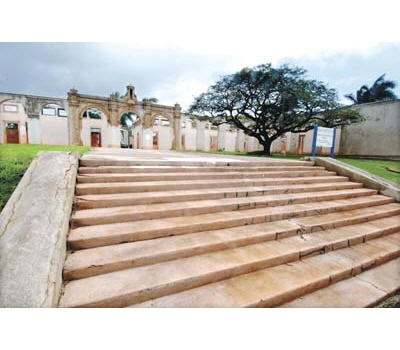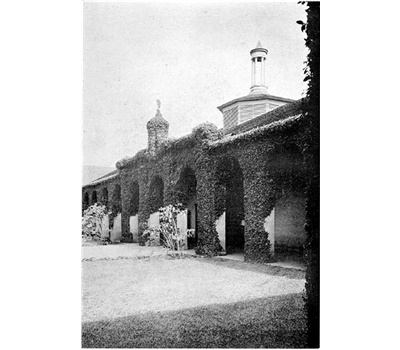Old Maui High picked for registries
By VALERIE MONSON, Maui News
6/2/06
WAILUKU – Old
Maui High – the first modern public high school on the island and the place that
molded a young Patsy Takemoto Mink into a national leader of women’s rights –
has been nominated to the State and National Registers of Historic Places.
 |
|
With volunteers clearing
away wreckage left by vandals and a fire, including the crumbling
roof, the Old Maui High School’s administration building, designed
by famed architect Charles W. Dickey, remains structurally sound and
ready for restoration. Papers have been completed to nominate the
school to the State and National Registers of Historic Places.
Supporters of the project hope to restore the exterior and modernize
the interior.
The Maui News / MATTHEW THAYER photo |
The Maui County
Cultural Resources Commission unanimously endorsed the application presented to
them Thursday by Barbara Long, president of the Friends of Old Maui High.
“I think we should support this nomination 110
percent,” said commission Chairman Sam Kalalau III.
Backed by displays of photographs showing the school’s
proud history, Long read portions of an extensive application prepared by
historian Don Hibbard that detailed why Old Maui High should be included on the
elite list of the most significant buildings in the history of the state and the
nation.
“When I go out there and walk around, it’s like being
at a temple,” Long said after the meeting. “What moves me is the power that the
school has and the power it had on the kids who went there and who went on to so
many great accomplishments.”
 |
|
The outer walls of the Old Maui High
were covered with ivy during the school’s heyday in 1937 in this
photograph that appeared in the Silversword, the school yearbook. |
The nomination papers now must be signed by Mayor Alan
Arakawa, himself an Old Maui High graduate. If all goes well, the Hawaii
Historic Review Board could add the school to the State Register when it meets
June 24.
The centerpiece of the campus was the former
administration building designed by master architect Charles W. Dickey in 1921,
seven years after the school had opened its doors in more humble surroundings.
With its promenade of graceful archways and ornamental carvings, the
white-washed cement structure seemed more like an art gallery than a school.
“It was the first building of its type in Hawaii,” said
Long.
At that time, Old Maui High was part of the bustling
plantation community of Hamakuapo-ko. The school quickly changed the lives of
families for miles around.
“It used to be that you would go straight from the 8th
grade to the plantations,” said Long. “Enrollment at the school grew because
parents realized that here was a chance for their children to get an education
and have a better future.”
Among the noteworthy graduates: Family Court Judge
Hariette Holt and Mayor Elmer Cravalho (both classmates of Mink); Hawaii Supreme
Court Justice Soichi Ogata; Circuit Court Judges Kase Higa and George Fukuoka;
Maui County Council Member Velma McWayne Santos; state Sen. Mamoru Yamasaki;
Bank of Hawaii President Wilson Cannon; renowned ethnobotanist Beatrice Krauss;
James Y. Ohta, first Asian-American to be named as an executive in the Boy
Scouts of America; and Robert Hughes, director of the Hawaiian Sugar Planters
Association.
When the population shifted to Central Maui, the
plantation village was phased out and the school closed in 1972, relocating to
Kahului. Over the years, the building – now alone in the midst of sugar cane
fields – gradually fell into disrepair, suffering from vandals, fire and the
elements.
About 2? years ago, Community Work Day leader Jan
Dapitan began a grass-roots effort to restore the historic structure and turn it
into a training and educational center for those in need of a skill. Because the
purpose was in line with the social programs championed by Mink, it was proposed
to name the center after the congresswoman who had died a year before.
Long was among the early supporters of the project.
Once word got out, hundreds of alumni joined the cause, too. Long said the goal
is to restore the exterior of the building and to modernize the interior, using
environmentally friendly construction methods. As much lumber as possible has
been saved during cleanup projects to be used in the restoration.
The nomination papers also list Mink as the
“significant person” connected with the school. Raised in Hamakuapoko, Patsy
Takemoto graduated in 1944 as class president. She later recalled how Old Maui
High and its free-thinking faculty inspired her to realize that she was not
limited by her gender – an uncommon attitude in those days.
Principal Malcolm Clower “played a very significant
role in my development – my self-confidence as a person,” Mink told Sue Davidson
in the book, “A Heart in Politics,” published in 1994.
“It made no difference to him that I was a girl
student. He never indicated the slightest preference in deciding various tasks –
that it had to be given to a male or that it couldn’t be done by a female. I
think it was a mark of exceptional ability on his part to rise above the normal
stereotypes of the day.”
A school leader from the instant she stepped onto the
campus as a freshman, Mink went on to represent Maui in the Territorial and
state Legislatures and U.S. Congress. She was the first Japanese-American female
to be elected to the Territorial House of Representatives and was the first
Asian-American woman elected to Congress.
From the beginning, Mink was known for defending her
ideals, no matter what others thought.
“It is easy enough to vote right and be consistently
with the majority, but it is more often more important to be ahead of the
majority,” she told Davidson. “This means being willing to cut the first furrow
in the ground and stand alone for a while if necessary.”
A fierce opponent of the Vietnam War, Mink ran for
president in 1972 strictly on an anti-war platform. A year later, on the floor
of Congress, she became the first lawmaker to publicly call for the impeachment
of President Richard M. Nixon.
Mink’s legacy, however, will probably always live on in
Title IX, the landmark legislation that ensured equality for girls and women in
athletics and academics. The bill officially was named “The Patsy T. Mink Equal
Opportunity in Education Act” four years ago. Mink also has been credited with
increasing the number of women practicing medicine and law today.
In 2003, Mink was named to the National Women’s Hall of
Fame located in Syracuse, N.Y. Chris Moulton, assistant director for the
organization, talked about Mink in an interview with The Maui News.
“There are so many reasons Patsy Mink was chosen,” said
Moulton. “For all the work she did on behalf of women, immigrants and others who
might not have had a voice. And for her determination in everything she
undertook – she didn’t just start something, she followed it through.”
And it all began at Old Maui High.
 Valerie
Monson can be reached at
vmonson@mauinews.com.
Valerie
Monson can be reached at
vmonson@mauinews.com.


 Valerie
Monson can be reached at
Valerie
Monson can be reached at